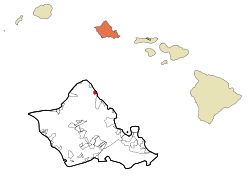Laie
| Laie, Hawaii | |
|---|---|
| Census-designated place | |

The Laie Hawaii Temple, the fifth oldest LDS Church temple worldwide
|
|
 Location in Honolulu County and the state of Hawaii |
|
| Coordinates: 21°38′55″N 157°55′32″W / 21.64861°N 157.92556°WCoordinates: 21°38′55″N 157°55′32″W / 21.64861°N 157.92556°W | |
| Country | United States |
| State | Hawaii |
| Area | |
| • Total | 2.1 sq mi (5.5 km2) |
| • Land | 1.3 sq mi (3.3 km2) |
| • Water | 0.9 sq mi (2.2 km2) |
| Elevation | 9 ft (3 m) |
| Population (2010) | |
| • Total | 6,138 |
| • Density | 2,900/sq mi (1,100/km2) |
| Time zone | Hawaii-Aleutian (UTC-10) |
| ZIP code | 96762 |
| Area code(s) | 808 |
| FIPS code | 15-43250 |
| GNIS feature ID | 0361691 |
Laie is a census-designated place (CDP) located in the Koolauloa District on the island of Oahu in Honolulu County, Hawaii, United States. In Hawaiian, lāʻie means "ʻie leaf" (ʻieʻie is a climbing screwpine: Freycinetia arborea). The population was 6,138 at the 2010 census.
Historically, Laie was a puʻuhonua, a sanctuary for fugitives. While a fugitive was in the pu'uhonua, it was unlawful for that fugitive's pursuers to harm him or her. During wartime, spears with white flags attached were set up at each end of the city of refuge. If warriors attempted to pursue fugitives into the puʻuhonua, they would be killed by sanctuary priests. Fugitives seeking sanctuary in a city of refuge were not forced to permanently live within the confines of its walls. Instead, they were given two choices. In some cases, after a certain length of time (ranging from a couple of weeks to several years), fugitives could enter the service of the priests and assist in the daily affairs of the puʻuhonua. A second option was that after a certain length of time the fugitives would be free to leave and re-enter the world unmolested. Traditional cities of refuge were abolished in 1819.
The history of Laie begins long before first contact. The name Laie is said to derive from two Hawaiian words: lau meaning "leaf", and ie referring to the ʻieʻie (red-spiked climbing screwpine, Freycinetia arborea), which wreaths forest trees of the uplands or mauka regions of the mountains of the Koʻolau Range behind the community of Laie. In Hawaiian mythology, this red-spiked climbing screwpine is sacred to Kane, god of the earth, god of life, and god of the forests, as well as to Laka, the patron goddess of the hula.
...
Wikipedia
